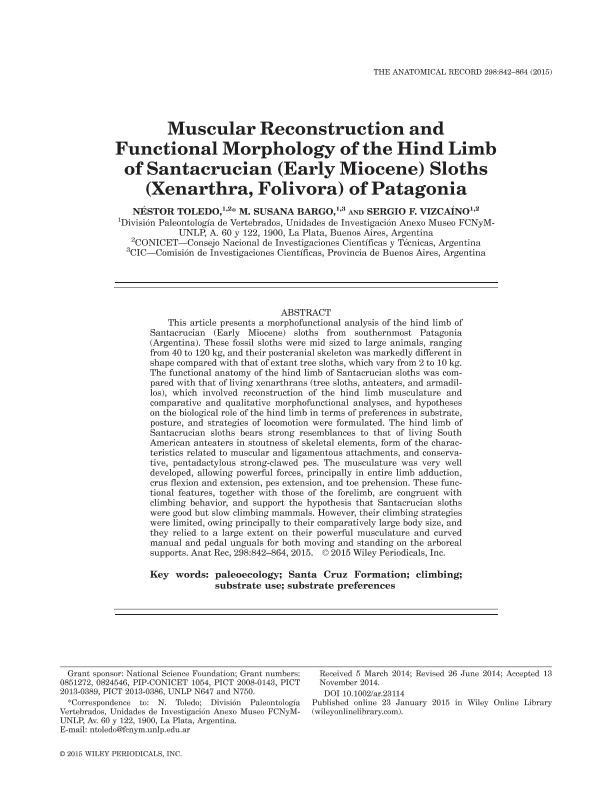Mostrar el registro sencillo del ítem
dc.contributor.author
Toledo, Néstor

dc.contributor.author
Bargo, María Susana

dc.contributor.author
Vizcaíno, Sergio Fabián

dc.date.available
2021-04-13T15:10:09Z
dc.date.issued
2015-05
dc.identifier.citation
Toledo, Néstor; Bargo, María Susana; Vizcaíno, Sergio Fabián; Muscular reconstruction and functional morphology of the hind limb of santacrucian (Early Miocene) sloths (Xenarthra, Folivora) of Patagonia; Wiley-liss, div John Wiley & Sons Inc.; Anatomical Record-Advances in Integrative Anatomy and Evolutionary Biology; 298; 5; 5-2015; 842-864
dc.identifier.issn
1932-8486
dc.identifier.uri
http://hdl.handle.net/11336/129932
dc.description.abstract
This article presents a morphofunctional analysis of the hind limb of Santacrucian (Early Miocene) sloths from southernmost Patagonia (Argentina). These fossil sloths were mid sized to large animals, ranging from 40 to 120 kg, and their postcranial skeleton was markedly different in shape compared with that of extant tree sloths, which vary from 2 to 10 kg. The functional anatomy of the hind limb of Santacrucian sloths was compared with that of living xenarthrans (tree sloths, anteaters, and armadillos), which involved reconstruction of the hind limb musculature and comparative and qualitative morphofunctional analyses, and hypotheses on the biological role of the hind limb in terms of preferences in substrate, posture, and strategies of locomotion were formulated. The hind limb of Santacrucian sloths bears strong resemblances to that of living South American anteaters in stoutness of skeletal elements, form of the characteristics related to muscular and ligamentous attachments, and conservative, pentadactylous strong-clawed pes. The musculature was very well developed, allowing powerful forces, principally in entire limb adduction, crus flexion and extension, pes extension, and toe prehension. These functional features, together with those of the forelimb, are congruent with climbing behavior, and support the hypothesis that Santacrucian sloths were good but slow climbing mammals. However, their climbing strategies were limited, owing principally to their comparatively large body size, and they relied to a large extent on their powerful musculature and curved manual and pedal unguals for both moving and standing on the arboreal supports.
dc.format
application/pdf
dc.language.iso
eng
dc.publisher
Wiley-liss, div John Wiley & Sons Inc.

dc.rights
info:eu-repo/semantics/openAccess
dc.rights.uri
https://creativecommons.org/licenses/by-nc-sa/2.5/ar/
dc.subject
CLIMBING
dc.subject
PALEOECOLOGY
dc.subject
SANTA CRUZ FORMATION
dc.subject
SUBSTRATE PREFERENCES
dc.subject
SUBSTRATE USE
dc.subject.classification
Paleontología

dc.subject.classification
Ciencias de la Tierra y relacionadas con el Medio Ambiente

dc.subject.classification
CIENCIAS NATURALES Y EXACTAS

dc.title
Muscular reconstruction and functional morphology of the hind limb of santacrucian (Early Miocene) sloths (Xenarthra, Folivora) of Patagonia
dc.type
info:eu-repo/semantics/article
dc.type
info:ar-repo/semantics/artículo
dc.type
info:eu-repo/semantics/publishedVersion
dc.date.updated
2021-04-12T16:21:03Z
dc.journal.volume
298
dc.journal.number
5
dc.journal.pagination
842-864
dc.journal.pais
Estados Unidos

dc.journal.ciudad
New York
dc.description.fil
Fil: Toledo, Néstor. Universidad Nacional de La Plata. Facultad de Ciencias Naturales y Museo. División Paleontología Vertebrados; Argentina. Consejo Nacional de Investigaciones Científicas y Técnicas. Centro Científico Tecnológico Conicet - La Plata; Argentina
dc.description.fil
Fil: Bargo, María Susana. Provincia de Buenos Aires. Gobernación. Comisión de Investigaciones Científicas; Argentina. Universidad Nacional de La Plata. Facultad de Ciencias Naturales y Museo. División Paleontología Vertebrados; Argentina
dc.description.fil
Fil: Vizcaíno, Sergio Fabián. Consejo Nacional de Investigaciones Científicas y Técnicas. Centro Científico Tecnológico Conicet - La Plata; Argentina. Universidad Nacional de La Plata. Facultad de Ciencias Naturales y Museo. División Paleontología Vertebrados; Argentina
dc.journal.title
Anatomical Record-Advances in Integrative Anatomy and Evolutionary Biology

dc.relation.alternativeid
info:eu-repo/semantics/altIdentifier/doi/http://dx.doi.org/10.1002/ar.23114
dc.relation.alternativeid
info:eu-repo/semantics/altIdentifier/url/https://anatomypubs.onlinelibrary.wiley.com/doi/full/10.1002/ar.23114
Archivos asociados
